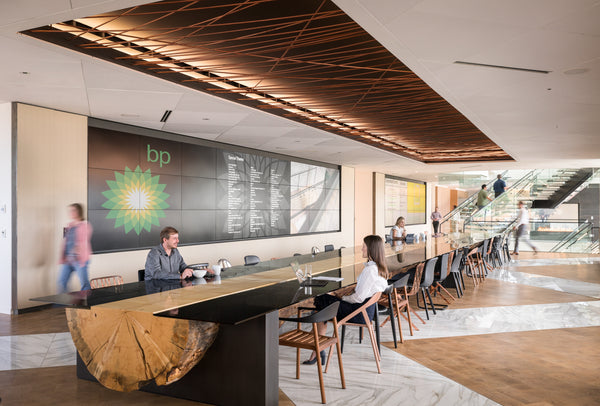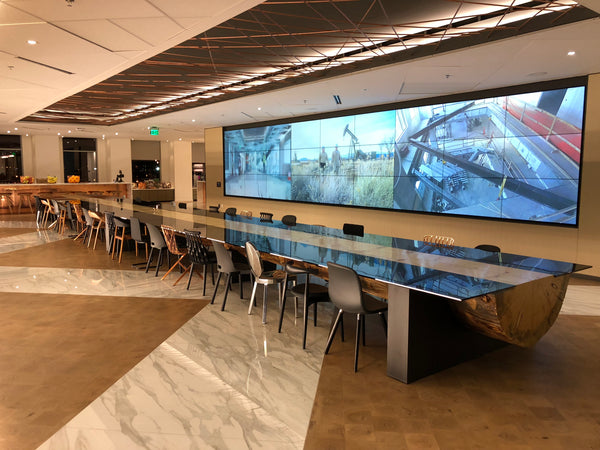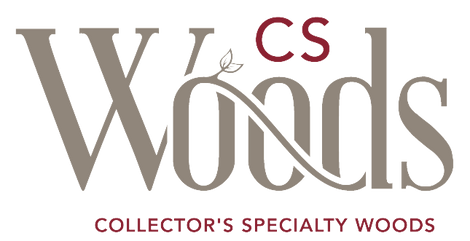One of a kind community table with seating for fifty crafted from a single log.
CS Woods locally sourced a lightning struck, dead standing, high altitude Engelmann Spruce, that became the foundation for this fifty two foot table. The tree was carefully felled and moved to our woodyard and woodshop in Southern Colorado. The log was milled through-and-through and then the halves were placed end to end to complete the length. The live edge was 3D mapped at leg and log intersections. Five perfectly scribed laser cut steel legs were made to cradle the log. The legs were bolted into the structure of the building in order to support the 22,000 pound table. Inlets were routed into each side of the length to house smoked glass that runs the full length of fifty two feet on each side. Narrow tunnels were carefully chiseled through the width of the tree that house steel beams to support the glass. The log was gently finished by hand with environmentally conscious products.
The fourth floor location required the coordination of both crane and gantry install. The steel legs, glass and log were carefully lifted to and through a large window and received on the other side by gantry. The logs were carefully lowered into the scribed legs and secured. Final sanding, finishing and install of glass was completed in the clients space.

The original concept and design emphasis was placed on beauty, sustainability and originality. The table is a gathering place for both dining and business, one that invites casual conversation, all hands meetings, and acts naturally as both a communication hub and a community lunch table. The table runs parallel to a wall of data monitors on one side and a mountain view with elevated open workspaces to the west. The original concept and design came from Workplace Elements and the client. Collector's Specialty Woods helped evolve the design and executed it.
This log table was one of 18 tables we competed for the same space, including a twenty six foot inverted river table out of black walnut and fourteen live edge conference tables out of elm.

Crane and Gantry Delivery
More Information about this project:
The Story of the Unity Table
Overview:
CSWoods locally sourced a lighting struck, dead standing, high altitude Engelmann Spruce, that became the foundation for the table. The client’s objective was to create a one of a kind community table with seating for fifty crafted from a single log. Original concept and design emphasis was placed on beauty, sustainability and originality. The table is a gathering place for both dining and business, one that invites casual conversation, all hands meetings, and acts naturally as both a communication hub and a community lunch table.
Story:
Kent adapted a concept photo, provided by Workplace Elements, of a table that was faux and veneer into a true through-and-through cut log table.
CSWoods looked all over Colorado for the perfect tree. We used our extensive list of loggers, mills and foresters. Final location: The tree was found and carefully felled for CSWoods by another Colorado family owned and operated circle saw mill, Hester’s Log and Lumber.
Hester’s Log & Lumber, a family-owned specialty lumber yard, opened in 1987 with humble hearts, one saw, and no office. Kent & Cindy Hester grew the business and are now happily retired and have handed over the reins and business to their oldest son, Forrest, and his wife Lindsey. Forrest and Lindsey work hard to provide the quality that Hester’s customers have come to expect. Not only are the owners keeping it in the family, but the millers are, too. They have several father / son teams on the saws, and half of their staff has been part of the Hester's Lumber family for more than 20 years.
After Kent made many research and measurement trips, the perfect log, and a test log, were trucked by Hester’s to the CSWoods woodshop, woodyard and drying facility in Southern Colorado.
Getting the cuts was one of the biggest challenges. The now 26’ log needed to be split down the exact middle. CSWoods had a newly installed 70” band mill that can do 40’ long, but it wasn’t as easy as “throw it on the saw mill”. The new mill still was not deep enough to accommodate the depth of the log. CSWoods outfitted the mill with a 70” chainsaw, adapting the new band mill into a chain mill. Because of the lightning strike and a heart check, one half of the log had integrity problems and could possibly split into two pieces once cut. Before initial milling, CSWoods doweled 1” oak across the heart check to stabilize. The log was split on the altered chain mill into two pieces. Two hours of chainsaw work later and it was cut through-and-through.
Even after standing dead for more than 20 years, the interior of the log tested at 13% moisture content, which is too high. CSWoods built an insulated box next to our vacuum kiln and kiln dried the two halves. After kiln drying, the logs were re-leveled on the bandsaw mill.
The next challenge was the leg design, placement and weight of the table. The original calculations gave us a weight of 28,000 pounds for the log and legs. After submitting to engineering it was essential to lighten the load. Because of the weight of the log CSWoods decided the way to proceed would be to produce steel legs that bolt into the concrete of the building. They would cradle the log, allowing for natural movement without affecting the base. Legs were lightened while still maintaining the solid metal look. The project ended at around 22,000 pounds. One of the complications in the initial design was how rest the log in the legs, keeping the live edge intact. The legs needed to be perfectly scribed to the natural live edge of the log while taking into account the lightning strike and the taper of the log. After much research and studying of the problem, we enlisted the help of a local metal worker, Billy Enyart who CSWoods has been working with for the last few years. We hired a 3D printing and scanning company in Broomfield, Colorado. They said they could 3D scan the entire log, locate the half inch steel leg walls in the exact location, and find the floor. The 3D scan would be accurate to within 1/1000th of an inch and provide an exact laser file. With that file, we would computer rendered 35 individual pieces that would come together to create the 5 legs. Each piece included tabs matching it to its mates to ensure accuracy.
The final leg design and plan was submitted to Workplace Elements to review leg width, placement, and final look. After approval, leg files were sent to one of the top laser C&C companies in Colorado and pieces were cut from 4’ x 10’ x 1” half inch steel plate.
Another one of the challenges was the two 52 feet long by 27 inches wide runs of smoked glass along each side of the log. In order to keep the heart of the log exposed at the center of the table and make the glass flush with the top along the edges, CSWoods milled 52 feet of inlets on each side. The glass channels required a 26 foot routing jig. The glass would also need to be both leveled and supported. The leveling needed to be adjustable over time to take into account the natural movement of the log. Kent designed and installed eighty five levelers which could be laser leveled in relationship to the legs. They are adjustable in the future as the log moves. CSWoods also custom engineered and built rubber bolts to protect the glass. To support the glass, CSWoods tunneled through the log right beneath the glass so and slid in 1 inch by 2 inch steel bars. The final engineering of the steel bars allowed for the weight of the glass to balance itself out on either side of the log. By pairing the sides through the log it solved both the weight problem and safety issue.
The table is the result of a through and through cut to a 26’ log with the halves laid end to end with the taper to the center. The two halves are pulled and held together. Inlet into the center joint of each log are metal ¾” by 8” plates that lag to each log. There is an access hole to allow for an Allen bolt to pull and hold the log halves together.
In order to preserve the natural aged patina, all knots were sanded and polished and all logging marks were sanded out. Logs were carefully detailed and finished. In order to harden the top of the pine log it received three penetrations of thin viscosity epoxy and two sealer coats of finish primer.
Table legs were set and bolted to the concrete, leveled by laser, and the floor was built in around them. The table logs were moved by Conestoga covered truck to BP’s Lower 48 location in Denver. They were unloaded, flipped and rigged to be moved by crane through a window to the fourth(?) floor. Rolling gantries received them on the other side of the window. Each log was gently lowered into its legs. The two halves were pulled together creating the final 52 foot unit. The table was finished in place by hand with four coats of eco friendly wood finish. Support bars were inserted through the log and attached. All 85 glass levelers were set by laser and ten pieces of 15 foot glass were set. Soft rubber pads were used to prevent the glass from slipping and moving.
POEM: UNITY TREE
We are humbled by her beauty. If only the tree could talk, I am sure she would have some incredible Colorado high country stories to tell. Starred nights and the milky way, draped in heavy winter snows. Morning eagle look out and a squirrel playground. Silent and steady keeper of the spring wild flowers. And then that stormy day when lighting struck, ripping a gash down the length. Now a beautiful table to be, for all to be inspired by Mother Nature’s wonder and majesty. "When you look at a tree and perceive its stillness, you become still yourself". Eckhart Tolle




